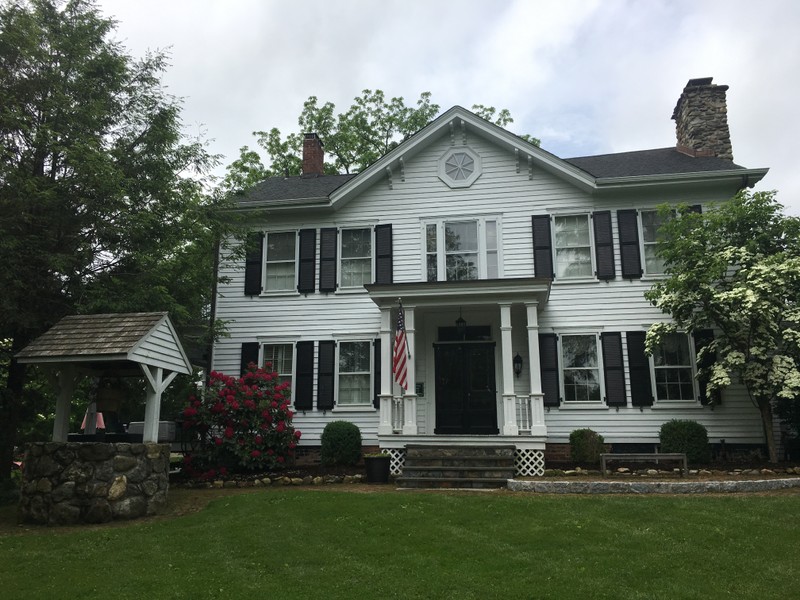Daniel Strang Homestead
Introduction
Text-to-speech Audio
Images
Daniel Strang Homestead (Modern Day)

Backstory and Context
Text-to-speech Audio
In the early 1700s, Daniel Strang, the son of a Huguenot who was naturalized in England also named Daniel Strang, settled in Yorktown after leaving his father’s property in New Rochelle. It was around 1728 that he settled with his wife Phoebe Purdy and their eight children at this homestead, less than a mile away from the First Presbyterian Church which served as the center point for the township of Crompond Corners. While not much is known about the Strang family’s involvement with the town at this point, it is assumed that the family’s loyalties were divided at the time the Revolutionary War broke out.
One of Daniel and Phoebe’s sons, Daniel Strang III, was arrested in Peekskill in 1776, on suspicion of being a spy for the British. He was apprehended while lurking around the army units stationed at the Peekskill Academy. When he was searched by Continental forces, they found several documents from British Colonel Robert Rogers who was commander of the Queen’s Rangers, the unit that would later become Simcoe’s Rangers. The documents, dated December 30, 1776, authorized Strang and others to recruit disaffected soldiers to the Rangers and detailed the terms and rewards that would be offered for recruitment. According to reports, Strang made no attempt to defend himself and on the authority of General Washington, he was tried and sentenced to death as a spy. He was hung on Oak Hill on the grounds of the Peekskill Academy on January 27, 1777 as the first spy to be tried and executed under the First Espionage Act passed by the Contented Congress in August of 1776. It is uncertain what happened to the Daniel Strang Homestead after the war, however rumors circulate about a stone outcropping under the house being used as a hiding place for loyalists and British sympathizers.
In 1812, Abraham Requa Strang was born in the home. A direct descendant of Daniel Strang the spy, he owned the home for many years until he moved to a home on Crompond Road. Ever the public servant, Abraham Requa Strang served on the town’s Board of Supervisors in 1852-53 as well as a member of the assembly of the First District of Westchester County in 1856. Additionally, he served as the County Superintendent for the Poor for over a decade in 1860-1872. Afterwards it was reported that the property was owned by James Knapp and family in the 1880s.
The homestead hasn’t changed much on the outside since the days of Daniel Strang. There is a newer addition on the north side of the house, but the rest has been maintained to look as it did in the 18th century. The barn behind the home and the old well on the property were all parts of the original construction. The inside of the home has also been restored to reflect the colonial era as faithfully as possible while still allowing for modern upgrades and newer technologies. A giant brass key hung near the front door is said to be the key to the original 18th century doors.
Cite This Entry
Brendan Murphy on behalf of Westchester County Historical Society. "Daniel Strang Homestead." Clio: Your Guide to History. July 29, 2020. Accessed March 23, 2025. https://theclio.com/entry/105759
Sources
“To George Washington from Major General William Heath, 19 January 1777,” Founders Online, National Archives, accessed September 29, 2019, https://founders.archives.gov/documents/Washington/03-08-02-0112. [Original source: The Papers of George Washington, Revolutionary War Series, vol. 8, 6 January 1777 – 27 March 1777, ed. Frank E. Grizzard, Jr. Charlottesville: University Press of Virginia, 1998, pp. 104–106.]
“To George Washington from Major General William Heath, 30 January 1777,” Founders Online, National Archives, accessed September 29, 2019, https://founders.archives.gov/documents/Washington/03-08-02-0201. [Original source: The Papers of George Washington, Revolutionary War Series, vol. 8, 6 January 1777 – 27 March 1777, ed. Frank E. Grizzard, Jr. Charlottesville: University Press of Virginia, 1998, pp. 189–190.]
“To George Washington from Major General William Heath, 4 January 1777,” Founders Online, National Archives, accessed September 29, 2019, https://founders.archives.gov/documents/Washington/03-07-02-0407. [Original source: The Papers of George Washington, Revolutionary War Series, vol. 7, 21 October 1776–5 January 1777, ed. Philander D. Chase. Charlottesville: University Press of Virginia, 1997, pp. 514–515.]
“To George Washington from Major General William Heath, 9 January 1777,” Founders Online, National Archives, accessed September 29, 2019, https://founders.archives.gov/documents/Washington/03-08-02-0028. [Original source: The Papers of George Washington, Revolutionary War Series, vol. 8, 6 January 1777 – 27 March 1777, ed. Frank E. Grizzard, Jr. Charlottesville: University Press of Virginia, 1998, pp. 26–28.]
Campbell, Charles A. “Peekskill Village in the Revolutionary War.” The Magazine of American History with Notes and Queries, 1877.
Scharf, J. Thomas. History of Westchester County: New York, Including Morrisania, Kings Bridge, and West Farms, Which Have Been Annexed to New York City. Vol. II. Philadelphia: L.E. Preston & Co., 1886.
Villadolid, Alice C. “The Hanging Tree of Peekskill.” The New York Times, June 24, 1979, sec. WC. https://www.nytimes.com/1979/06/24/archives/westchester-opinion-the-hanging-tree-of-peekskill.html.
Courtesy of the Yorktown Landmarks Preservation Commission

